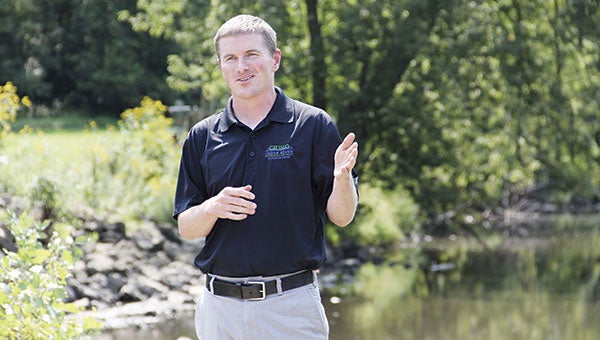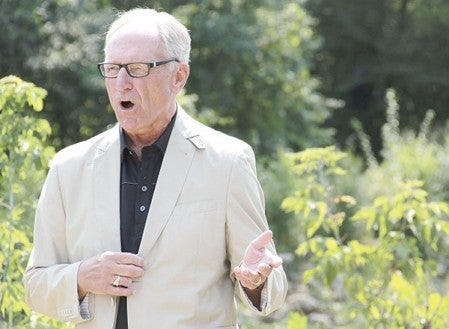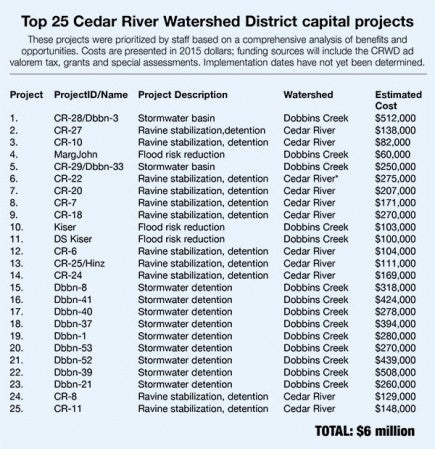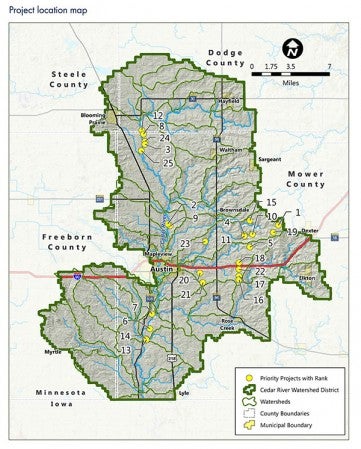Crystal clear future; Leaders announced $3.2 million grant for water quality projects
Published 10:11 am Thursday, August 27, 2015

Cedar River Watershed District Resource Specialist Justin Hanson talks about the CRWD’s efforts to clean waterways after it was announced that The Hormel Foundation will give $3.2 million to fund half the $6.4 million Accelerated Results Plan for projects on the Cedar River and Dobbins Creek. Photos by Jason Schoonover/jason.schoonover@austindailyherald.com
The Hormel Foundation and Vision 2020 didn’t start the fire when it comes to cleaning two of Austin’s biggest waterways, but they’ve provided resources to help spark water quality projects to a whole new level.
Community leaders gathered at the confluence of the Cedar River and Dobbins Creek in Austin’s Driesner Park Wednesday afternoon to announce a $3.2 million Hormel Foundation grant to accelerate the Cedar River Watershed District’s efforts to improve water quality and reduce flooding on the Cedar and Dobbins.
“Just the fact that we’re going to be cleaning up the waterways in and out of Austin [and] in Austin is a huge, huge step in the right direction,” Hormel Foundation Chairman Gary Ray said.
The Hormel Foundation’s $3.2 million grant is the largest in the CRWD’s history and will cover half a $6.4 million plan that’s been dubbed the Accelerated Results Plan, which features 25 permanent projects to start in 2016, many of which are upstream from Austin along the Cedar and Dobbins.
“This is a five-year project,” Ray said. “Things like this don’t just happen overnight. It’s going to take a lot of handwork to make this thing now really a reality.”

Hormel Foundation Gary Ray talks about $3.2 million grant to the Cedar River Watershed District Wednesday at Driesner Park. Jason Schoonover/jason.schoonover@austindailyherald.com
Bridging partnerships
When Vision 2020 formed, one of its goals was to embrace and maintain Austin’s waterways, and the idea for a CRWD-Hormel Foundation partnership stems from Vision 2020’s Waterways committee.
Vision 2020 Director of Vision Creation Laura Helle called the project a great fit for Vision 2020, as it could help provide additional resources to something already going on in Austin.
“This is one of those crystal clear examples of the purpose of Vision 2020,” Helle said. “We want to take something that’s happening in our community and really pour gasoline on the fire.”
Vision 2020 volunteer Greta Anderson recalled the Waterways committee researching local water issues after it formed. They found the CRWD was already making headway on local issues. However, they discovered CRWD had a backlog of projects and was in need of more resources and funding to take their water quality efforts to the next level.
Statewide funding for clean water projects can be limited, CRWD Resource Specialist Justin Hanson noted.
“We haven’t had the leveraged funds to get big scale projects,” Hanson said.
Vision 2020 asked the CRWD to form the Accelerated Results Plan.
Hanson thanked Vision 2020 leaders for pushing them.
“You guys challenged us to think big and by doing so we have an opportunity to do big things,” Hanson said.
While the 25 projects outlined in the plan will take time, Anderson touted CRWD’s track record of success. Its work has kept 1,512 tons of sediment on land since 2012 and its held 632 pounds of phosphorus on the land. CRWD was also named watershed district of year by the Minnesota Department of Natural Resources in 2012 and by Izaak Walton League in 2013.
Thus far, CRWD has secured landowner agreements on 13 of the 25 projects, which consists of 11 sites along the Cedar River (with four south of Austin) for ravine projects and 14 in the Dobbins Creek sub-watershed for storm water detention and flood-risk reduction structures.
“We’re hoping they can accomplish things up north that will eventually help us here in Austin,” Ray said.
Ray applauded CRWD leaders for doing their homework and building strong working relationships with area farmers.
“The Cedar River [Watershed] has developed a relationship that goes far beyond some of the other watershed districts here in the state of Minnesota,” Ray said. “And in turn, this will help make this much more successful as we move forward in working with the landowners and understanding their situations and their problems.”
‘Fired up’
Many CRWD projects completed thus far have been smaller, and its regular operations have averaged about $50,000 per year in capital projects. Since the CRWD formed in 2007, it hasn’t always had the funding or the capability to match large projects.
Hanson said the CRWD board and staff is chomping at the bit and they have already gotten on some projects to be able to hit the ground running next spring.
“We’re fired up,” Hanson said.
Hanson called the private capital investment from the foundation a unique one that puts CRWD ahead of the curve.
“Starting today, we’re a notch above a lot of other areas, and we look forward to that challenge of meeting the expectations of the volunteers and the foundation and making a project that we can all be proud of,” Hanson said.
Ray called the plan a “huge step” in cleaning the water coming into Austin and leaving Austin. He added the project was a no-brainer for the foundation and its board, as it will affect health, quality of life, recreational opportunities, and it will be good for the community.
“In light of all the things that are going on today in the environment and the changes that we’re going through, it only makes sense for a project like this to happen,” Ray said.





